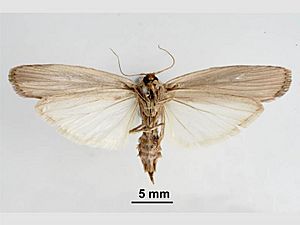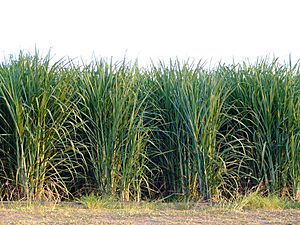Eldana facts for kids
Quick facts for kids Eldana |
|
|---|---|
 |
|
| Dorsal view | |
 |
|
| Ventral view | |
| Scientific classification | |
| Synonyms | |
|
The Eldana moth is a type of moth with only one known species. It's called the African sugar-cane borer (Eldana saccharina). You can find these moths in many parts of Africa, like Equatorial Guinea, Ghana, Mozambique, Sierra Leone, and South Africa.
Adult moths have light brown front wings with two small spots. Their back wings are also light brown. When their wings are spread, they measure about 35mm across. This moth is important to people because its young, called larvae, are a big problem for crops. They especially like sugarcane, but also eat sorghum, maize, cassava, and rice. The larvae bore into the stems of these plants. This causes a lot of damage, which is why they are called "borers." The African sugar-cane borer is a tough pest. It can even survive when farmers burn their fields. Farmers try different ways to stop them, like planting different crops together or using tiny helpful wasps.
Contents
What the African Sugar-Cane Borer Looks Like
Adult African sugar-cane borers are quite small. Their body is about 3mm wide. Their wingspan, when fully open, is about 35mm. The front wings are a pale brown color. They have two clear dark brown spots in the middle. The back wings are a whitish-brown. They have short fringes and brown lines. Male and female moths look very similar. However, females are usually a bit bigger. When the moth rests, it folds its front wings over its body. This covers its white back wings.
Where They Live
The Eldana saccharina moth is originally from Africa. It lives all over sub-Saharan Africa. You can find it in countries like Equatorial Guinea, Ghana, Mozambique, Sierra Leone, and South Africa. There are also some in northern Africa, like Ethiopia and parts of Senegal. Cold weather stops them from spreading too far in these areas.
These moths mostly live in sedges and wild grasses. They like areas near rivers. But lately, they have started moving into farm fields. They especially like grain crops in eastern and southern Africa. The type of soil also matters. You will find fewer of these moths in sandy soils.
What They Eat
Favorite Plants
Sugarcane is the main plant the African sugar-cane borer eats. This is how it got its common name. But it also attacks other important crops. These include maize, sorghum, cassava, and rice. They also eat wild grasses like Guinea grass. Wetland plants like papyrus and typha are also on their menu.
You can tell if E. saccharina is in a plant by looking for tunnels in the stems. You might also see broken plant stems. When these moths infest sugarcane, it can cause farmers to lose a lot of their crop.
How They Lay Eggs
Female African sugar-cane borers like to lay their eggs on dry or dead leaves. They are attracted to special chemicals in these dead leaves. These chemicals tell the females where to lay their eggs. The females hide their eggs between leaf surfaces. They lay them in tight groups of about 300 eggs.
How They Communicate
African sugar-cane borers communicate in ways that are still being studied. Like other moths, they use ultrasound. This is a sound that humans can't hear. They make this sound using a special body part called a tymbal. When male moths make ultrasound sounds, female moths might flap their wings. This sound also tells other males to stay away. If two males meet, they circle each other. They make bursts of sound. One male will usually chase the other away. When a male approaches a female, she might walk past or make her own sounds. If she replies, the male might touch her antennae with special "hair-pencils." These actions are different from mating rituals.
Life Cycle
Egg Stage
The eggs are yellow and oval-shaped. Females lay them in groups of 250 to 500. They place them on the inside of leaf sheaths. These are parts of the plant that wrap tightly around the stem. This helps the eggs fit snugly. After being laid, the eggs usually hatch in 5 to 7 days.
Larva Stage
African sugar-cane borer larvae (caterpillars) can be light brown to dark gray. They have a distinct brown plate on their upper body. The larva stage usually lasts about 31 days. Larvae spread out from where they hatched after 1 to 3 days. If a predator comes near, the larvae squirt a brownish liquid from their mouths. This helps to scare predators away. After hatching, the larvae first feed on the outside of plants. Then, they tunnel into the stems. This is where they will turn into pupae. This tunneling behavior is why they are called "borers."
Pupa Stage
The pupa stage is when the moth changes from a larva to an adult. During this time, the pupae are hidden inside the host plants. They stay very close to an exit hole, which is visible on the plant's surface. African sugar-cane borers usually stay in the pupa stage for 7 to 13 days. After this, they come out of the exit hole. While inside the plant, pupae are very hard to remove. They can even survive if the crop fields are burned.
Adult Stage
Adult African sugar-cane borers come out of the exit holes in their host plants. They usually appear after the temperature drops quickly. Then, they climb up and spread their wings. After about 10 to 15 minutes, their new wings are ready. Newly emerged adults only live for about 6 to 13 days. Females spend two days getting ready to lay eggs. Then they have about 4 days to reproduce. Because they live for such a short time, females likely only mate once.
Enemies of the Moth
Predators
Like other moths, African sugar-cane borers are most likely to die when they are eggs or larvae. Several types of ants and mites eat the eggs of E. saccharina. Small ants like Pheidole are good at reaching the eggs. The eggs are often hidden in tight spots behind leaf sheaths. Mite predators are not as well understood. But they are a big problem for the moths. This is because mites are tiny and found in large numbers where the moths live. Larger, more aggressive ants like Dorylus and some spiders eat the moth larvae. These predators often attack young larvae that are moving around. They also attack larvae that have not yet bored into the plant stems.
Parasites
Several parasites attack E. saccharina larvae. The most important one is a tiny wasp called Goniozus natalensis. This wasp attacks larvae that are in their fourth, fifth, and sixth growth stages. G. natalensis wasps are attracted to the holes the moth larvae make in plants. After entering, they sting the larva. This temporarily paralyzes it. Then, the wasp lays its eggs on the moth larva. G. natalensis wasps prefer to lay eggs on female moth larvae. Their eggs hatch after three days. The young wasps then eat the E. saccharina larvae.
How They Mate
Attracting Mates
After becoming adults, male African sugar-cane borers get their wings ready. About 30 minutes later, they start trying to attract females. They face downwards and beat their wings very fast. Males often gather in groups of 3 to 6 on the same plant. This makes it easier for females to find them. This wing-beating can last for 15 to 20 minutes. During this time, males might stay still or move a little before starting again. Females, if they are there, also start a similar wing-flapping behavior. This male behavior also releases a special scent called a pheromone. This scent attracts females from far away. Male mating behavior stops if the temperature drops below 15 degrees Celsius.
Courting
The courting behavior of African sugar-cane borers has only been seen once in the wild. When a male meets a female, he faces her with his antennae extended. Then, the two moths rotate in a circle. The male follows the female. The female shows her interest by spreading her wings.
Pheromones
Male African sugar-cane borers release pheromones to attract females. These special scents come from glands on their wings and from "hair-pencils" on their abdomen. Scientists have found that one main chemical makes up this scent.
How Humans Deal with Them
Crop Pests
The larvae of the African sugar-cane borer enter mature plants through cracks or openings in the stem. They can survive when farmers burn crops. They hide inside the base of the plant. They will come out as soon as new, young plant shoots appear. These moths are more common in large, industrial sugarcane farms. This is because these farms often use fertilizers with high nitrogen levels. Also, the plants might be stressed from not enough water.
Removing Dry Leaves
African sugar-cane borers like to lay eggs in dry leaves. So, farmers came up with a simple method called "pre-trashing." This means removing dry or dead leaves from sugarcane fields before the moths lay eggs. This stops the moths from laying eggs in new fields. If there are any hidden eggs, they would be moved too far from the plant stem for the larvae to reach. However, this method can sometimes damage the growing plants and reduce the amount of crop harvested.
Planting Different Crops Together
One common way to fight E. saccharina is to plant target crops with other plants that the moths don't like. This is called intercropping. These "trap plants" attract female moths to lay eggs there. But the eggs often don't develop well, or at all, on these plants. Scientists are also trying to create new sugarcane plants that are naturally resistant to these pests.
Using Biopesticides
Other natural methods are also used against E. saccharina. Two types of parasitic wasps, Cotesia flavipes and Xanthopimpla stemmator, attack the African sugar-cane borer larvae. These wasps lay their eggs on the moth larvae. When the wasp eggs hatch, the young wasps eat the moth larvae. This method is very helpful for larvae that have already bored into the plant. These larvae are usually very hard to reach.
Silicon Treatment
In many plants, adding silicon can make the plant stronger against pests. This is because silicon makes the plant cells harder. Studies show this works well for the African sugar-cane borer. Sugarcane treated with silicon had fewer larvae boring into them. The larvae also gained less weight. Pests eating silicon-treated plants ate less food. They also had lower survival rates and slower population growth. In potted sugarcane plants, silicon treatment not only reduced pest damage but also helped the plants handle water stress better. However, these studies did not say how silicon treatment affected the quality of the sugarcane product.
Images for kids



